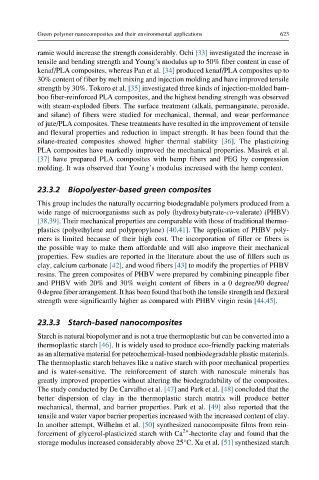Page 678 - Polymer-based Nanocomposites for Energy and Environmental Applications
P. 678
Green polymer nanocomposites and their environmental applications 623
ramie would increase the strength considerably. Ochi [33] investigated the increase in
tensile and bending strength and Young’s modulus up to 50% fiber content in case of
kenaf/PLA composites, whereas Pan et al. [34] produced kenaf/PLA composites up to
30% content of fiber by melt mixing and injection molding and have improved tensile
strength by 30%. Tokoro et al. [35] investigated three kinds of injection-molded bam-
boo fiber-reinforced PLA composites, and the highest bending strength was observed
with steam-exploded fibers. The surface treatment (alkali, permanganate, peroxide,
and silane) of fibers were studied for mechanical, thermal, and wear performance
of jute/PLA composites. These treatments have resulted in the improvement of tensile
and flexural properties and reduction in impact strength. It has been found that the
silane-treated composites showed higher thermal stability [36]. The plasticizing
PLA composites have markedly improved the mechanical properties. Masirek et al.
[37] have prepared PLA composites with hemp fibers and PEG by compression
molding. It was observed that Young’s modulus increased with the hemp content.
23.3.2 Biopolyester-based green composites
This group includes the naturally occurring biodegradable polymers produced from a
wide range of microorganisms such as poly (hydroxybutyrate-co-valerate) (PHBV)
[38,39]. Their mechanical properties are comparable with those of traditional thermo-
plastics (polyethylene and polypropylene) [40,41]. The application of PHBV poly-
mers is limited because of their high cost. The incorporation of filler or fibers is
the possible way to make them affordable and will also improve their mechanical
properties. Few studies are reported in the literature about the use of fillers such as
clay, calcium carbonate [42], and wood fibers [43] to modify the properties of PHBV
resins. The green composites of PHBV were prepared by combining pineapple fiber
and PHBV with 20% and 30% weight content of fibers in a 0 degree/90 degree/
0 degree fiber arrangement. It has been found that both the tensile strength and flexural
strength were significantly higher as compared with PHBV virgin resin [44,45].
23.3.3 Starch-based nanocomposites
Starch is natural biopolymer and is not a true thermoplastic but can be converted into a
thermoplastic starch [46]. It is widely used to produce eco-friendly packing materials
as an alternative material for petrochemical-based nonbiodegradable plastic materials.
The thermoplastic starch behaves like a native starch with poor mechanical properties
and is water-sensitive. The reinforcement of starch with nanoscale minerals has
greatly improved properties without altering the biodegradability of the composites.
The study conducted by De Carvalho et al. [47] and Park et al. [48] concluded that the
better dispersion of clay in the thermoplastic starch matrix will produce better
mechanical, thermal, and barrier properties. Park et al. [49] also reported that the
tensile and water vapor barrier properties increased with the increased content of clay.
In another attempt, Wilhelm et al. [50] synthesized nanocomposite films from rein-
2+
forcement of glycerol-plasticized starch with Ca -hectorite clay and found that the
storage modulus increased considerably above 25°C. Xu et al. [51] synthesized starch

